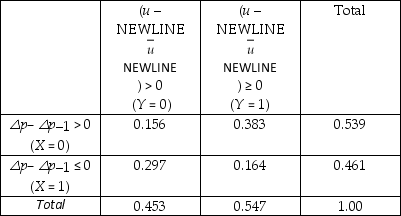The expectations augmented Phillips curve postulates
△p = π - f (u -  ),
),
where △p is the actual inflation rate,π is the expected inflation rate,and u is the unemployment rate,with "-" indicating equilibrium (the NAIRU - Non-Accelerating Inflation Rate of Unemployment).Under the assumption of static expectations (π = △p-1),i.e. ,that you expect this period's inflation rate to hold for the next period ("the sun shines today,it will shine tomorrow"),then the prediction is that inflation will accelerate if the unemployment rate is below its equilibrium level.The accompanying table below displays information on accelerating annual inflation and unemployment rate differences from the equilibrium rate (cyclical unemployment),where the latter is approximated by a five-year moving average.You think of this data as a population which you want to describe,rather than a sample from which you want to infer behavior of a larger population.The data is collected from United States quarterly data for the period 1964:1 to 1995:4.
Joint Distribution of Accelerating Inflation and Cyclical Unemployment,
1964:1-1995:4
 (a)Compute E(Y)and E(X),and interpret both numbers.
(a)Compute E(Y)and E(X),and interpret both numbers.
(b)Calculate E(Y  = 1)and E(Y
= 1)and E(Y  = 0).If there was independence between cyclical unemployment and acceleration in the inflation rate,what would you expect the relationship between the two expected values to be? Given that the two means are different,is this sufficient to assume that the two variables are independent?
= 0).If there was independence between cyclical unemployment and acceleration in the inflation rate,what would you expect the relationship between the two expected values to be? Given that the two means are different,is this sufficient to assume that the two variables are independent?
(c)What is the probability of inflation to increase if there is positive cyclical unemployment? Negative cyclical unemployment?
(d)You randomly select one of the 59 quarters when there was positive cyclical unemployment ((u -  )> 0).What is the probability there was decelerating inflation during that quarter?
)> 0).What is the probability there was decelerating inflation during that quarter?
Definitions:
Independent Contractors
Individuals who are in business for themselves, providing goods or services to another entity as a non-employee, typically on a contract basis.
Workforce
The collective group of individuals engaged in or available for work, either in a specific area or in a particular industry or occupation.
Advantages
Benefits or favorable traits that give something or someone a superior position or condition compared to others.
Respondeat Superior
A legal doctrine holding an employer or principal legally responsible for the wrongful acts of an employee or agent, if such acts occur within the scope of the employment or agency.
Q4: When the errors are heteroskedastic,then<br>A)WLS is efficient
Q10: In the case of the simple regression
Q23: Under imperfect multicollinearity<br>A)the OLS estimator cannot be
Q26: The probit model<br>A)is the same as the
Q35: To compare the slope coefficient from the
Q37: You set out to forecast the unemployment
Q43: A VAR with k time series variables
Q44: If the null hypothesis states H0 :
Q48: Your textbooks gives several examples of quasi
Q63: You have obtained a sub-sample of 1744